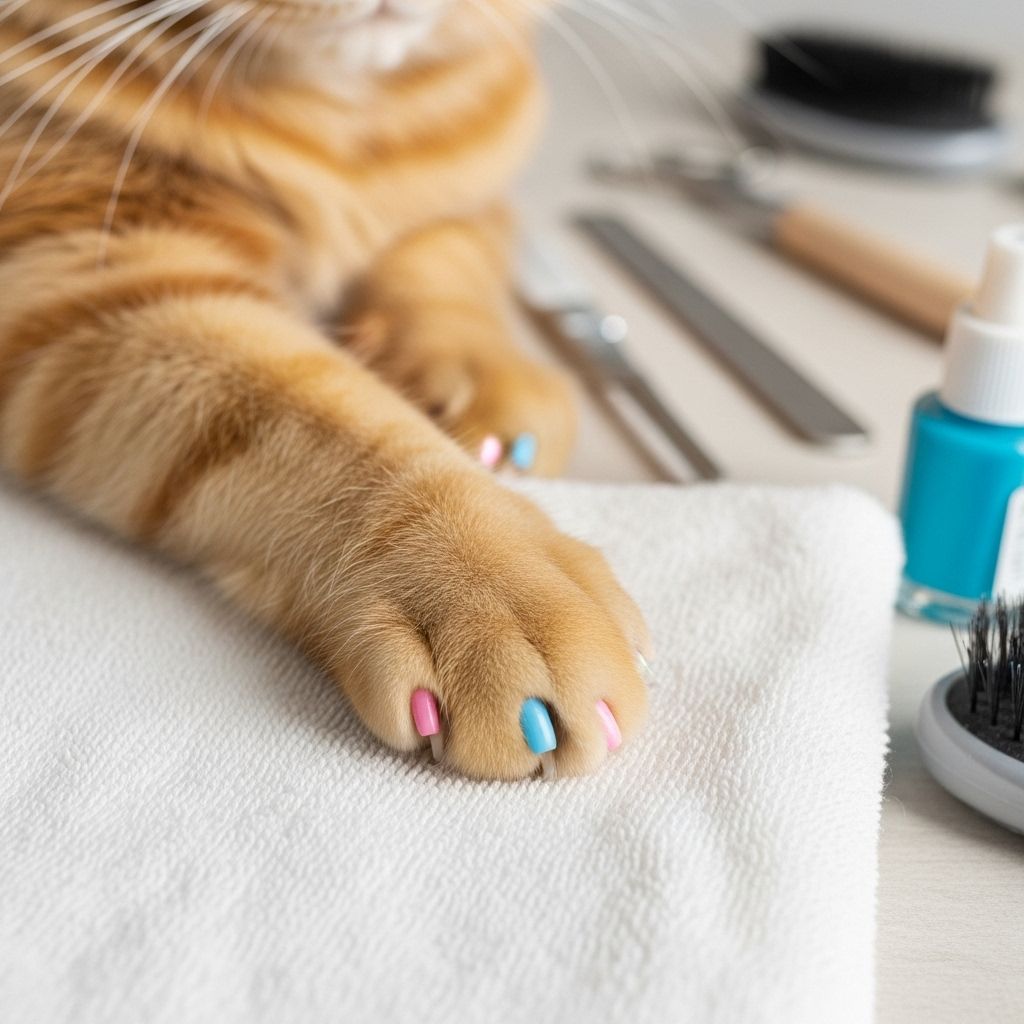Is It Safe To Paint Your Cat’s Nails? Risks And Safe Claw Care
Gentle grooming protects felines from toxins while supporting natural comfort and play.

Is It Safe to Paint Your Cat’s Nails?
Decorating pets has become an increasingly visible trend on social media, with images and videos of painted cat nails rapidly gaining popularity. While these colorful displays may seem cute or harmless, the reality is far more complex. Before you reach for a bottle of polish or custom nail glue, it’s important to understand the health implications, toxicity risks, ethical considerations, and better alternatives for your cat’s claws. This article takes an in-depth look at painting cat nails, so you can make the most informed and responsible choice for your feline companion.
Table of Contents
- Why Do People Want to Paint Cat Nails?
- Is Nail Polish Safe for Cats?
- Toxicity and Dangers of Human Nail Products
- What About Cat Nail Caps?
- Potential Complications and Risks
- Safer Alternatives for Cat Claw Care
- Best Practices for Responsible Cat Nail Care
- Frequently Asked Questions
Why Do People Want to Paint Cat Nails?
Social media and pop culture have made pet nail art an eye-catching trend, inspiring many cat owners to experiment with painting their cats’ nails. The motivations are varied, but commonly include:
- Desire to beautify or accessorize pets for photos or special occasions.
- Imitating online celebrities or viral videos featuring decorated animals.
- Assuming it’s a harmless and fun way to pamper a pet.
- Confusing nail painting with protective claw caps (which are a different product).
However, what may seem like a harmless fashion statement can have real health and behavioral consequences for cats.
Is Nail Polish Safe for Cats?
The short answer: No – painting a cat’s nails is not considered safe or recommended by veterinarians, especially when using products designed for humans.
Here’s why:
- Cats are prone to grooming themselves. They lick their paws and nails, which makes it very likely that any applied polish will be ingested. Unlike humans, cats cannot be told not to touch or lick their painted nails until the product has dried or cured.
- Human nail polishes, including many labeled “non-toxic” or “child-safe,” often contain ingredients that are dangerous or toxic to animals even in small amounts.
- Even “pet-safe” polishes should never be applied without careful consideration, veterinary approval, and knowledge of ingredients.
Veterinary Perspective
- Most veterinarians strongly advise against using human nail polish or chemical products on cats.
- If you’re ever unsure or considering a “pet-friendly” cosmetic, consult your veterinarian before proceeding.
Toxicity and Dangers of Human Nail Products
Typical nail polishes are chemical cocktails containing ingredients such as:
- Toluene: A solvent that can cause neurological damage, headaches, dizziness, and respiratory issues if inhaled or ingested.
- Formaldehyde: A well-known carcinogen and irritant. Even skin contact or fumes from this chemical are hazardous to both people and pets.
- Dibutyl phthalate: A plasticizer linked to hormonal disruptions and organ toxicity.
- Acetone: Found in removers; highly toxic if ingested and rapidly absorbed through skin and mucous membranes.
Despite some brands marketing themselves as “toxin-free,” studies have shown that the labeling of nail products is not always reliable. Products labeled safe or toxin-free have sometimes been found to contain hazardous chemicals, further underscoring the risk to pets.
How Could Nail Polish Harm Cats?
- Gastrointestinal upset (vomiting, diarrhea), drooling, or lethargy after licking or chewing painted nails.
- Neurological symptoms such as wobbliness, tremors, or seizures in severe poisoning cases.
- Oral irritation and ulceration if the chemicals are ingested or come in contact with gums and mouth tissue.
- Respiratory distress from inhaling fumes during application or after.
- Allergic reactions or dermatitis from direct skin or nail bed contact with polish.
In short, even after the polish dries, chemical residues can remain, especially as cats wear down their polish and expose their skin to the substances beneath.
What About Cat Nail Caps?
Some people confuse nail painting with nail caps (also known as claw covers). Unlike painting, nail caps are small, typically soft and colorful plastic or silicone coverings glued over the claws. These do not create a painted effect, but rather cover the sharp points to prevent scratching or damage. Major differences include:
| Feature | Nail Caps | Nail Polish/Painting |
|---|---|---|
| Purpose | Blunt claws to prevent scratches | Cosmetic/fashion only |
| Formulation | Soft plastic, pet-grade glue | Chemical polish, solvents |
| Application | Placed over trimmed claws | Brushed or painted directly |
| Recommended? | With Vet Guidance | Not recommended |
Are Nail Caps Safe?
- If applied properly and removed as claws grow, nail caps are considered safe for most indoor cats.
- They are sometimes recommended for cats who scratch excessively, get stuck in soft furnishings, or need protection for themselves (such as hairless breeds or cats with skin conditions).
- Brands like Soft Paws or Soft Claws are vet-recommended; avoid off-brands without proven safety.
Nail caps should never be used on cats who go outdoors, as claws are needed for defense and climbing.
Application can be tricky: many cats dislike having their paws handled, and improper use can pose health risks (see below).
Potential Complications and Risks
Nail Painting
- Acute poisoning: From licking, chewing, or inhaling fumes.
- Long-term health effects: Chronic low-dose exposure to toxins from repeated applications.
- Pain, stress, and trauma: For many cats, restraint and paw handling is distressing.
Nail Caps
- Complications from improper application: May cause nail bed irritation, inflammation, or lead to infections if glue seeps below the cap.
- Choking hazard: If a cat chews off a cap and swallows it, intestinal blockage or choking can occur.
- Mobility issues: Caps may restrict a cat’s ability to grip, climb, or move comfortably, especially in active or athletic cats.
- Behavioral stress: Some cats are intolerant of the sensation and may develop anxiety or stress-related issues.
Safer Alternatives for Cat Claw Care
Rather than painting or applying caps for cosmetic reasons, prioritize natural and health-focused claw care:
- Regular nail trimming: Trimming your cat’s nails every 2–4 weeks can minimize damage to furniture and skin, and reduce the urge to scratch excessively.
- Scratching posts and pads: Provide sturdy, enticing posts or horizontal scratching pads to satisfy natural scratching instincts.
- Environmental enrichment: Toys, cat trees, and interactive play distract from destructive scratching.
- Training and redirection: Reward your cat for using designated scratch areas and discourage inappropriate scratching with gentle correction techniques.
How to Safely Trim Your Cat’s Claws
- Wait until your cat is calm—after a meal, playtime, or bath.
- Gently handle paws to acclimate your cat and reduce sensitivity.
- Use pet-grade clippers designed for cats, trimming only the sharp tip (avoid the “quick”).
- Offer treats and praise for cooperation.
- Enlist a second person for gentle restraint if needed, or wrap your cat in a towel (“cat burrito”).
- Stop immediately if you see bleeding; use styptic powder to clot the nail.
Best Practices for Responsible Cat Nail Care
To keep your cat safe, healthy, and happy, follow these grooming guidelines:
- Avoid using human beauty products (polish, glue, removers) on cats.
- Consult your veterinarian before using any non-medical product on your cat’s body, especially cosmetics or adhesive products.
- If using nail caps, have them applied professionally or after thorough training, checking daily for wear or damage.
- Prioritize routine trimming, scratching outlets, and environmental enrichment over cosmetic alterations.
- Be aware that some cats will never tolerate paw handling, and forcing the issue may increase fear and distrust.
Frequently Asked Questions (FAQs)
Q: Are there any “cat-safe” nail polishes?
A: While a few companies market “pet-safe” polishes, most veterinarians urge extreme caution. Pet-safe does not mean edible or non-toxic if licked. Always check with your vet about any product for your cat.
Q: Can painting my cat’s nails help prevent scratching?
A: No. Nail painting serves no protective or behavioral function. If your cat’s scratching is destructive, explore nail caps (with guidance), regular trimming, or environmental changes instead.
Q: Do vets recommend nail caps? Are they humane?
A: Some vets recommend nail caps for specific indoor cats as a less drastic alternative to declawing. They are humane if properly applied, not overused, and the cat tolerates them. They are not suitable for outdoor cats.
Q: Is nail painting painful for cats?
A: The process of restraining and applying polish can be stressful or painful, particularly if polish gets on sensitive skin, cuticles, or if they struggle during application. Polish chemicals can also burn or irritate tissue.
Q: What if my cat ate nail polish?
A: Contact your veterinarian or an animal poison control center immediately. Do not induce vomiting or delay intervention; some polish chemicals can cause severe toxicity rapidly.
Q: Should I declaw my cat instead?
A: Veterinary consensus is strongly against declawing. Declawing involves amputation of the last toe bone, causing lifelong pain, behavior issues, and disability, and is banned or restricted in many countries.
Key Takeaways
- Never use human nail polish or beauty products on cats due to the high risk of toxicity and health complications.
- Nail caps are a non-toxic, temporary option for specific indoor cats, but require proper application, monitoring, and vet approval.
- Frequent nail trimming and environmental enrichment are the safest, most humane ways to manage scratching and claw care.
- Protect your cat’s health, comfort, and natural behaviors—choose responsible grooming over cosmetic trends.
References and Further Reading
- Consult your local veterinarian for advice tailored to your cat.
- For poison emergencies: American Society for the Prevention of Cruelty to Animals (ASPCA) Animal Poison Control Center.
References
- https://rexipets.com/blogs/the-latest/cat-nail-caps-pros-and-cons
- https://thecatisinthebox.com/blogs/kitty-contemplations/are-nail-caps-or-claw-covers-for-cats-safe
- https://www.vendeeni.net/article/whether-cat-eye-nail-polish-is-safe.html
- https://www.dvm360.com/view/are-pets-risk-secondary-exposure-nail-polish-toxins
- https://www.aspcapetinsurance.com/resources/caring-for-cats-nails/
Read full bio of Anjali Sayee












